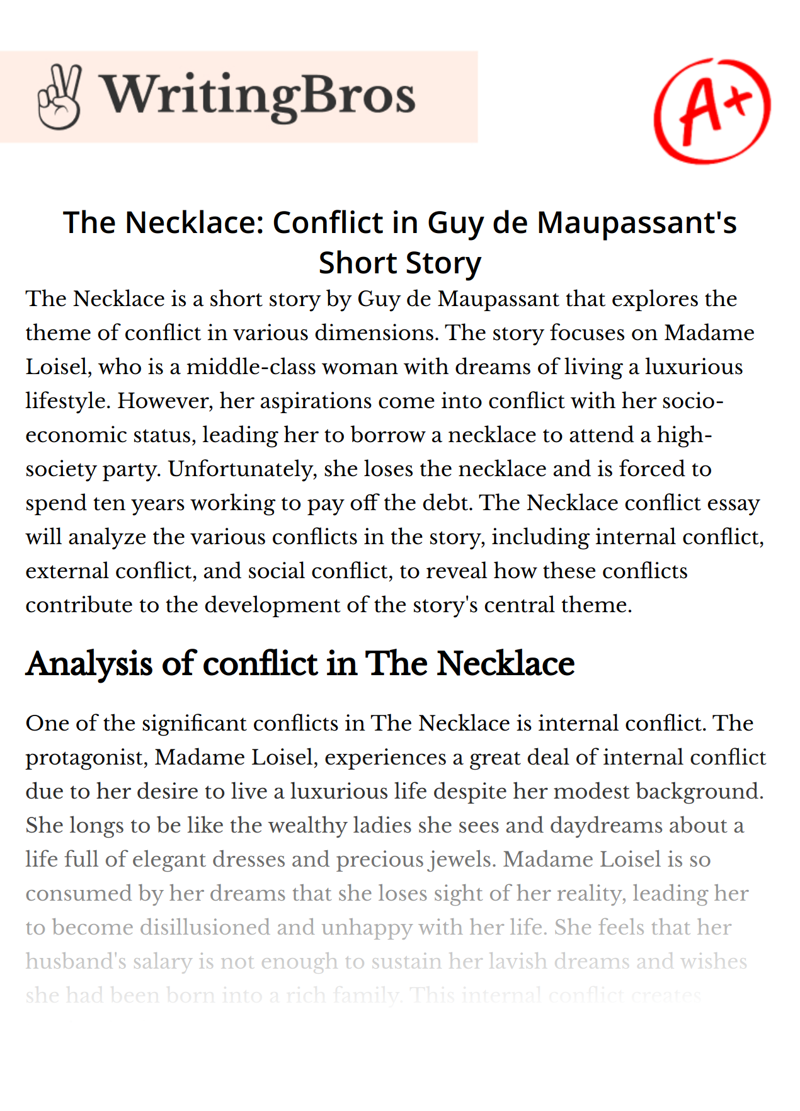The Necklace: Conflict in Guy de Maupassant's Short Story

The Necklace is a short story by Guy de Maupassant that explores the theme of conflict in various dimensions. The story focuses on Madame Loisel, who is a middle-class woman with dreams of living a luxurious lifestyle. However, her aspirations come into conflict with her socio-economic status, leading her to borrow a necklace to attend a high-society party. Unfortunately, she loses the necklace and is forced to spend ten years working to pay off the debt. The Necklace conflict essay will analyze the various conflicts in the story, including internal conflict, external conflict, and social conflict, to reveal how these conflicts contribute to the development of the story's central theme.
Analysis of conflict in The Necklace
One of the significant conflicts in The Necklace is internal conflict. The protagonist, Madame Loisel, experiences a great deal of internal conflict due to her desire to live a luxurious life despite her modest background. She longs to be like the wealthy ladies she sees and daydreams about a life full of elegant dresses and precious jewels. Madame Loisel is so consumed by her dreams that she loses sight of her reality, leading her to become disillusioned and unhappy with her life. She feels that her husband's salary is not enough to sustain her lavish dreams and wishes she had been born into a rich family. This internal conflict creates tension in the story, and Madame Loisel's dissatisfaction with her life sets up the story's main conflict.
External conflict of The Necklace is another significant theme. The loss of the necklace creates an external conflict that changes Madame Loisel's life forever. She is forced to borrow a necklace from her friend and then loses it while at the party. Madame Loisel and her husband are faced with the difficult task of replacing the necklace without their friend discovering the loss. The external conflict of the lost necklace leads to the Loisel's financial ruin, and the couple is forced to spend years paying off the debt incurred to purchase the replacement necklace. The external conflict creates tension in the story and ultimately leads to the resolution of the plot.
Social conflict is also prevalent in The Necklace. Madame Loisel's desire to live a luxurious life stems from her social status and her desire to be accepted in high society. She is obsessed with the idea of status and wealth and wishes to move up in society. Her husband's meager income and modest background create social conflict, and Madame Loisel feels like an outsider in the world she so desperately wants to be a part of. This social conflict creates tension in the story and highlights the difficulties faced by those who are unable to move up in social class.
In conclusion, Guy de Maupassant's The Necklace explores the theme of conflict in various dimensions. The internal conflict experienced by Madame Loisel due to her desire to live a luxurious life creates tension and sets up the story's central conflict. The external conflict of the lost necklace leads to the Loisel's financial ruin, and the couple is forced to spend years paying off the debt incurred to purchase the replacement necklace. The social conflict created by Madame Loisel's desire to move up in society highlights the difficulties faced by those who are unable to move up in social class. The conflicts in the story work together to create a tale of a woman's desire for something beyond her means and the consequences that result from her choices. The Necklace is a cautionary tale about the importance of being content with what one has and the dangers of succumbing to envy and desire.
References
- de Maupassant, G. (1884). The Necklace. Gil Blas, 4(77), 1-4.
- Diamond, A. (1978). The necklace and the mirror: The image of woman in La Vie Parisienne. The Romanic Review, 69(4), 311-323.
- Doyle, C. (2013). Realism and the Problem of Real Life in Maupassant's Fiction. French Forum, 38(2), 59-77.
- Fiorenzo, M. (2015). Irony, satire and parody in Guy de Maupassant’s short stories: A stylistic analysis. International Journal of Humanities and Social Science Research, 5(2), 32-45.
- Fowlie, W. (1940). Maupassant and the French Short Story. PMLA, 55(3), 671-690.
- Khalili, M., & Jamshidi, M. (2012). A Marxist reading of Maupassant's "The Necklace". International Journal of Applied Linguistics and English Literature, 1(6), 56-62.
Cite this Essay
To export a reference to this article please select a referencing style below

